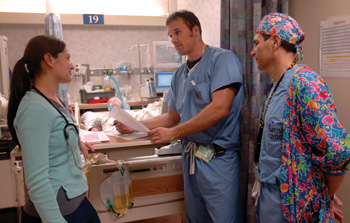
William Byrd III, M.D., an anesthesiology resident, center, and Matthew Weinger, M.D., of anesthesiology, talk with Melody Flores, R.N., about handing off a patient from the recovery room to an inpatient room.
Photo by Dana Johnson
Study seeks to plug patient information gaps
Gaps in information have been shown to be one of the major causes of medical errors leading to adverse events.
These gaps can occur between health care providers (called hand-offs) or between technology or systems and people. The Institute of Medicine has estimated that medical errors are the eighth leading cause of death among Americans.
Vanderbilt University Medical Center has received a two-year, $600,000 grant from the Agency for Healthcare Research and Quality to study the impact of interdisciplinary training in improving hand-off effectiveness. It will allow a team of clinicians to focus on interpersonal communication, using both standardized patients and mannequin-based simulators to enhance training effectiveness. The grant will also include a way to assess hand-off performance in the clinical environment, both pre- and post-training.
The grant was one of 18 awarded by AHRQ in November.
“For many health care providers, navigating the handoff of a complex patient may be similar to navigating a labyrinth — a maze of intricate combinations of passages,” said Matthew Weinger, M.D., director of the Simulation Technologies Program of the Vanderbilt Center for Experiential Learning. “Navigating this maze of communication must lead to an effective and efficient patient hand-off, but without a standardized approach for delivering and receiving the information, a quality patient hand-off is much more difficult to attain.”
The Vanderbilt project includes developing, administering, and then evaluating the efficacy of a training intervention called STRAIT (Simulation Training for Rapid Assessment and Improved Teamwork). The Vanderbilt project, designed to be generalized to other areas, will initially focus on patient hand-offs between VUMC anesthesia providers and recovery room nurses in both the Post-Anesthesia Care Units (PACU) of both the adult and children's hospitals.
A patient hand-off is interactive communication allowing the opportunity for questioning between the giver and receiver of patient information, and should include up-to-date information on the patient's care, treatment, services, condition and any recent or anticipated changes. Weinger says that recent research suggests that the most effective hand-offs are not just reports but actual conversations between two individuals with common goals.
The hand-off should be structured so that the information is presented in a consistent way so the health care provider knows everything he or she needs to know about the patient and can figure out whether any information is missing.
“The big picture goal here is to use simulation to improve communication,” Weinger said. “Health care providers don't communicate with each other very well for a variety of reasons. The biggest problem is across disciplines — especially between physicians and nurses — because that's where most of the communications occur.”
Weinger said the communication barriers exist because nurses and doctors are trained differently, and learning good people skills hasn't traditionally been part of medical training. “On top of that, at least until recently, most nurses have been women and the vast majority of physicians were men, and there are a certain amount of communication issues between the genders.”
The training will work like this: physicians and nurses will come together to Vanderbilt's Center for Experiential Learning and Assessment, to practice the hand-offs. Two types of simulation will be used in the training — the mannequin-based simulator and the standardized clinician.
“Using a mannequin patient, we can simulate the clinical situation where the anesthesia provider might be in the middle of a hand-off to the recovery room nurse when the (simulated) patient suddenly stops breathing or has a low blood pressure,” Weinger said.
The standardized clinicians are individuals (not necessarily actual clinicians) trained to be a PACU nurse or the anesthesia provider in a very specific scenario. “This allows us to do training in an area which I think is really important — how do you deal with someone who is not communicating effectively, whether they're angry or they're inappropriate,” Weinger said. “One of the areas we've imbedded into this training is conflict resolution. These are the more generalizable skills we want to disseminate.”
Weinger said that grant will also allow assessment of the training, measuring the clinicians' performances both before and after the training. Observers will watch actual hand-offs both before and after training, and they will rate them using a structured and validated communication and teamwork scoring system that is currently being developed.
The interdisciplinary grant project team includes nurses, anesthesiologists, psychologists and educators. Project team leaders include Audrey Kuntz, M.D., Dan France, Ph.D., Ted Speroff, Ph.D., and Jason Slagle, Ph.D. The research team is currently designing the curriculum, designing and piloting the data collection forms and training the observers. The actual PACU observations are expected to begin in February, and the training in late spring 2007.
Weinger says the project is strongly supported by senior VUMC Perioperative nursing and anesthesiology leadership.
Weinger is the Norman Ty Smith Chair in Patient Safety and Medical Simulation, professor of Anesthesiology, Biomedical Informatics and Medical Education and director of the Vanderbilt Center for Perioperative Research in Quality.













